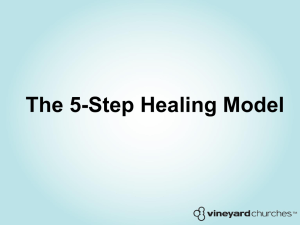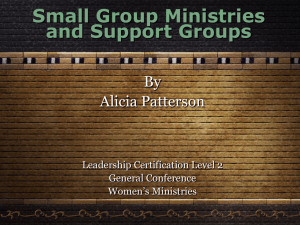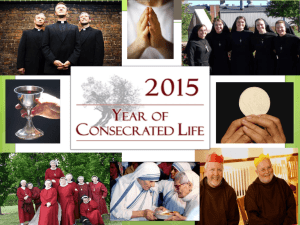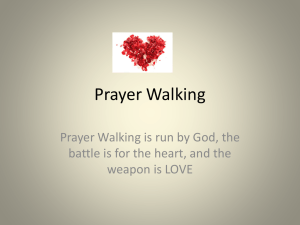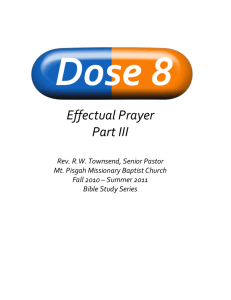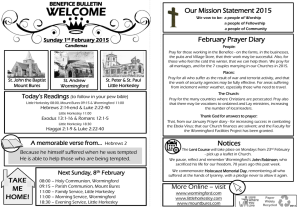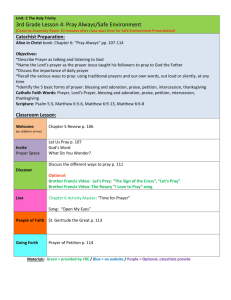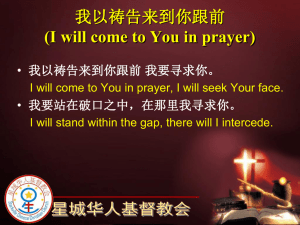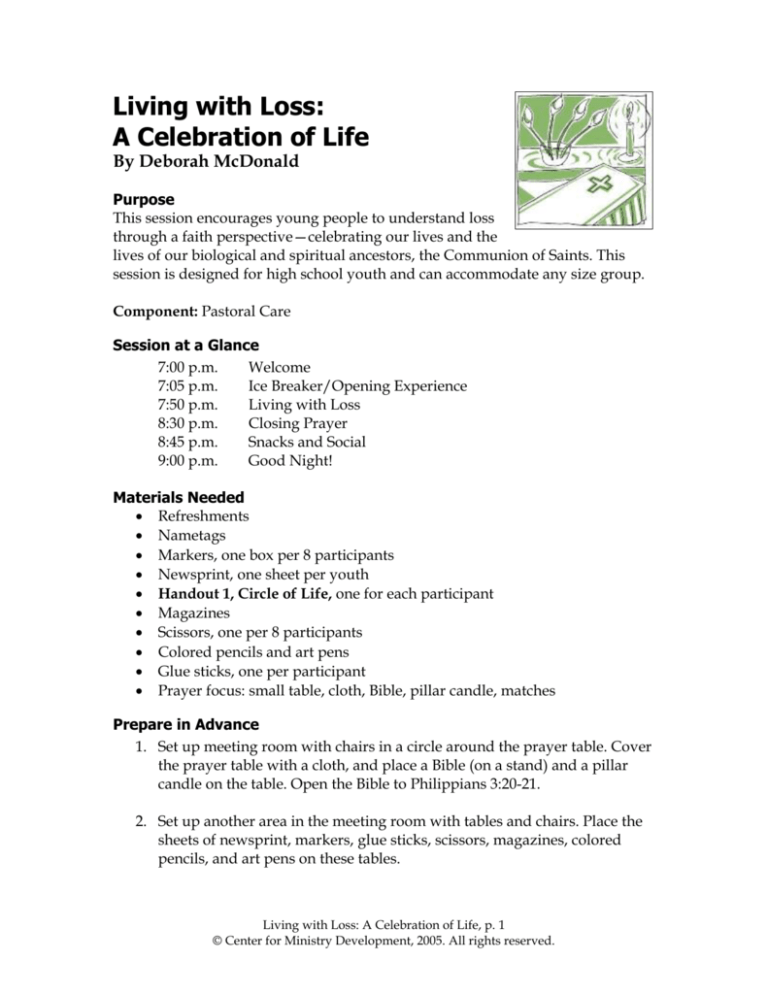
Living with Loss:
A Celebration of Life
By Deborah McDonald
Purpose
This session encourages young people to understand loss
through a faith perspective—celebrating our lives and the
lives of our biological and spiritual ancestors, the Communion of Saints. This
session is designed for high school youth and can accommodate any size group.
Component: Pastoral Care
Session at a Glance
7:00 p.m.
Welcome
7:05 p.m.
Ice Breaker/Opening Experience
7:50 p.m.
Living with Loss
8:30 p.m.
Closing Prayer
8:45 p.m.
Snacks and Social
9:00 p.m.
Good Night!
Materials Needed
Refreshments
Nametags
Markers, one box per 8 participants
Newsprint, one sheet per youth
Handout 1, Circle of Life, one for each participant
Magazines
Scissors, one per 8 participants
Colored pencils and art pens
Glue sticks, one per participant
Prayer focus: small table, cloth, Bible, pillar candle, matches
Prepare in Advance
1. Set up meeting room with chairs in a circle around the prayer table. Cover
the prayer table with a cloth, and place a Bible (on a stand) and a pillar
candle on the table. Open the Bible to Philippians 3:20-21.
2. Set up another area in the meeting room with tables and chairs. Place the
sheets of newsprint, markers, glue sticks, scissors, magazines, colored
pencils, and art pens on these tables.
Living with Loss: A Celebration of Life, p. 1
© Center for Ministry Development, 2005. All rights reserved.
3. Invite all participants to bring a minimum of 5 “family” pictures to the
gathering—pictures of siblings, parents, guardians, grandparents, great
grandparents, friends, neighbors, and personal heroes (the people can be
living or dead). Participants may bring copies instead of the actual photos.
4. Create your personal Circle of Life (using Handout 1) prior to the session
to share with the group.
5. Review Resource 1, Resources and Websites for Teens on Grief and
Loss.
Gathering and Welcome (5 minutes)
Create a welcoming environment for youth as they enter. Invite youth and team
members to make and wear a nametag. Welcome participants, and introduce
yourself and any other team members. Provide a brief overview of tonight’s
session. Say something like:
How many of you have experienced the death of a friend or a loved one?
Dealing with the death of someone we love is hard. When someone dies, our
minds are filled with feelings and memories of that person. Because of that,
we like to share stories about the person—we remember, and we tell their
story to friends and family.
Imagine your last family gathering, lots of food and laughter. Christmas,
Thanksgiving, birthdays, weddings, and funerals are times for us to gather
and to celebrate who we are as family, to tell our stories. Telling stories
about the past, laughing about silly moments, remembering family members
and friends who have died, are an important part of family events.
Tonight we will explore what we, as Catholics, believe about death and how
we celebrate the living memory of those who came before us by telling the
story.
Ice Breaker/Opening Experience (45 minutes)
Step 1 (20 minutes): Creating Circles of Life
Invite the participants to bring their family/friend pictures and gather around
the worktables. Say something like:
Finding out about our roots, creating a “family tree”—this is what genealogy
is. Family trees tell a story. Our roots are the people who came before us—
our ancestors. The branches are those who will come after us—our
descendants. At the end of the movie, The Lion King, Simba’s family gathers
round him to celebrate his life. Everyone from his community family and
friends are there. Looking down from the mountain are his deceased relatives.
Tonight we are going to create our own Circle of Life using Handout 1 and the
pictures that you brought to the session, and the art supplies on the table.
Living with Loss: A Celebration of Life, p. 2
© Center for Ministry Development, 2005. All rights reserved.
Once everyone has gathered around the work tables, distribute Handout 1,
Circle of Life, and let them know they will have 15 minutes to complete their
Circle of Life.
Step 2 (25 minutes): After sufficient time is given for everyone to complete his or
her Circle of Life, invite the youth to gather together. Invite the participants to
share their Circle of Life. Begin by sharing yours as an example. Perhaps tell a
brief story about a member of your living family or one who has died.
Note to Leader: For large groups, consider doing this activity in small groups of 57.
Living with Loss (40 minutes)
Step 1 (5-8 minutes): Once everyone has shared, invite youth to gather in groups
of 6–8, selecting one person to be their small group secretary and spokesperson.
Instruct the groups to discuss and answer the following questions:
The loss of a friend or family member impacts our lives. How?
Experiencing an illness and or death, a family or community tragedy is
emotional. How and what did you feel? What helped you cope with the loss?
What did not help?
Step 2 (15 minutes): Ask the spokesperson from each group to share highlights
from their group’s discussion. As the groups take turns sharing, incorporate the
following points into the discussion:
▪ Everyone grieves.
▪ Grief and loss are a normal part of life.
▪ Children, teens, adults, parents, spouses, and elderly all have unique ways
of coping with death that is age and situation appropriate.
▪ Teens need to talk about the death, what happened, memories, talk about
how it feels and ask lots of questions.
▪ Teens and adults need people to be honest. It’s important to talk openly
about the person who has died or is sick. Trying to protect someone’s
feelings by hiding the truth is not helpful.
▪ Teens need to grieve at his or her pace. At times it’s important for teens to
be with friends and hang out—taking time away from the intense grief and
loss, finding a balance between grief and the activities of teen life.
▪ No one can take the place of the person who has died. When a parent dies,
the teen does not become a parent or the head of the household.
▪ Being angry is normal. Questioning—Why did it happen? Could it have
been avoided?—is normal. Being mad at the deceased for abandoning
his/her friends and family is normal. Being mad at God is normal.
Living with Loss: A Celebration of Life, p. 3
© Center for Ministry Development, 2005. All rights reserved.
▪ Feeling regret is normal—wondering why we didn’t tell the person how
important they were to us, how loved they were, being concerned about a
fight, etc.
▪ Grief does not go away overnight. Grief takes time—sometimes months,
sometimes years. Grief is not something we get over—it is something we
learn to live with.
▪ It is normal to cry, to feel physically exhausted, to feel heartache.
▪ Making connections to our Catholic faith—praying for the deceased,
investigating what Catholics believe about death and eternal life, asking
questions—are part of the experience of grieving. Attending the wake and
the funeral are an important part of the grieving process.
Step 2 (20 minutes): Distribute Handout 2, What Do We Believe about Life after
Death. Instruct the participants to read the handout, and in their small groups
identify Catholic beliefs about life after death from the readings. Allow about 10
minutes for the groups to complete this task. When the small groups are finished,
ask:
What connections if any can be made between the list of beliefs and our
Circle of Life experience/discussion?
Closing Prayer (15 minutes)
Gather
Invite everyone to gather around the prayer table. Dim the room lights if
possible. Light the prayer candle.
Prayer Leader:
Light and peace in our Lord, Jesus Christ.
Listen
Invite the young person to proclaim Philippians 3:20-21. Allow a few moments
for quiet reflection after the reading is proclaimed.
Respond
Prayer Leader:
Tonight we have listened to the stories of those who came before us, friends,
family, teachers, parents, loved ones. Remembering those who came before
us in faith is an ancient tradition of the Catholic Church. Tonight, let us
remember our friends and loved ones. As we pray our intercessions, I invite
you to say aloud their names.
Intercessions
Prayer Leader:
Living with Loss: A Celebration of Life, p. 4
© Center for Ministry Development, 2005. All rights reserved.
Let us offer our prayers and thanks to God. Our response is “Lord, hear our
prayer.
We pray in thanksgiving for our family and friends who have died and now
rest in the arms of Christ. Tonight, we remember in a special way… (pause
and invite participants to call out the names of their deceased friends/family).
We ask that they be granted eternal rest and that perpetual light may shine
upon them. We pray . . .”
We pray in thanksgiving for each person gathered here tonight, that they may
go forward to live lives of love, to live the challenge of Jesus’ love. We pray…
For what else shall we pray this evening? We pray…
Go Forth
Prayer Leader:
Let us pray together the prayer that our Lord taught us to pray. Our Father...
Prayer for All Souls Day
Let us pray for all our departed brothers and sisters, God our creator and
redeemer, by your power Christ conquered death and returned to you in
glory. May all your people who have gone before us in faith share his victory
and enjoy the vision of your glory forever.
And may God bless us, in the name of the Father, and the Son, and the Holy
Spirit.
All: Amen.
(Sacramentary, p. 1096)
Snack and Social Time (15 minutes)
Invite the participants to stay and have refreshments and continue telling stories
of their loved ones.
This session was written by Deborah McDonald, Director of Youth Ministry,
Archdiocese of Washington. Debbie holds a Master of Social Work degree from
Virginia Commonwealth University School of Social Work and is an Accredited
Certified Social Workers.
Living with Loss: A Celebration of Life, p. 5
© Center for Ministry Development, 2005. All rights reserved.
Handout 1
Circle of Life
Great
Grandparents
Grandparents
Relatives
Friends
Family
You
Using this sheet as a guide, create your Circle of Life on a sheet of newsprint.
1. Place your name (picture) date of birth in the center.
2. In each of the surrounding circles put the names/pictures, birthday, place
of birth, and year of their death (if appropriate) of individuals in your life
that fit the category.
3. Feel free to use magazine pictures or drawings to symbolize the life of the
person named or a happy memory.
Living with Loss: A Celebration of Life, p. 6
© Center for Ministry Development, 2005. All rights reserved.
Handout 2
What Do We Believe about Life after Death?
We firmly believe, and hence we hope that, just as Christ is truly risen from the
dead and lives for ever, so after death the righteous will live forever with the
risen Christ and he will raise them up on the last day.
Catechism of the Catholic Church, 939
In the communion of saints,” a perennial link of charity exists between the
faithful who have reached their heavenly home, those who are expiating their
sins in purgatory and those who are still pilgrims on earth.
Catechism of the Catholic Church, 1475
Prayer of Commendation
(Final prayer at a Catholic funeral)
Our/brother/sister (name of the deceased) has fallen asleep in Christ. Confident
in our hope of eternal lie, let us commend him/her to the loving mercy of our
Father and let our prayers go with him/her. He/she was adopted as God’s
son/daughter in baptism and was nourished at the table of the Lord; may
he/she now inherit the promise of eternal life and take his/her place at the table
of God’s children in heaven.
Let us pray also on our own behalf, that we who now mourn and are saddened
may one day go forth with our brother/sister to meet the Lord of Life when he
appears in glory.
(Rites of the Catholic Church, Vol. I. Chicago IL: The Liturgical Press, 1990, p. 1096.)
Living with Loss: A Celebration of Life, p. 7
© Center for Ministry Development, 2005. All rights reserved.
Resource 1
Resources and Websites for Teens on Grief and Loss
http://www.adec.org/pdf/RespondingtoTeenGrief2.pdf
“Responding to Teen Grief” by Linda Goldman (in Adobe format)
http://www.americanhospice.org/grieving-children/articles
Articles on grief and bereavement
http://wnyafn.com/teengrief/
Helping Teens Cope with Grief
http://www.focusas.com/Grief.html
Focus Adolescent Services
Books
www.amazon.com
The Grieving Teen: A Guide for Teenagers and Their Friends
Helen Fitzgerald. New York: Simon & Schuster (Fireside Books), 2000.
When a Friend Dies: A Book for Teens About Grieving and Healing
Marilyn E. Gootman. Minneapolis MN: Free Spirit Publishing, 1994.
Straight Talk about Death for Teenagers: How to Cope with Losing Someone You Love
Earl A. Grollman. Boston: Beacon Press, 1993.
Healing Your Grieving Heart for Teens
Alan D. Wolfelt. Fort Collins CO: Companion Press, 2001.
Living with Loss: A Celebration of Life, p. 8
© Center for Ministry Development, 2005. All rights reserved.

